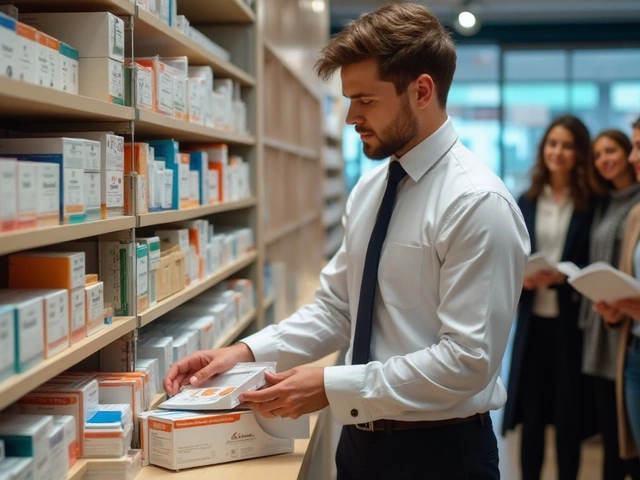Understanding U.S. Customs Rules for Prescription Medicine Imports
You’d be surprised how many Americans think the whole ‘prescription shopping in Canada’ routine is a gray area. Actually, U.S. customs rules are complicated but not a free-for-all. U.S. law generally says it's illegal to import drugs not approved by the FDA. Yet, small amounts for personal use often slip through, thanks to a sort of unstated tolerance policy. So, what counts as 'personal use'? Most border officers will treat a 90-day supply in your luggage as acceptable—if you’ve got your doctor’s prescription in hand. Anything that looks like you’re bringing in for resale, or way more than you can take in three months, and you’re asking for trouble at the checkpoint.
Now, here’s what rarely gets talked about: U.S. Customs and Border Protection (CBP) actually has a “Personal Importation Policy” that gives agents some flexibility. They may allow a drug if it’s clearly for your own use, your condition is serious, there’s no FDA-approved drug available in the U.S. for your problem, and you promise in writing you won’t sell it. But don’t expect a free pass if you’re shipping home a trunkload of antibiotics or controlled substances like ADHD meds or opioids—those are watched much more closely, and the DEA can step in if they feel something is off. When it comes to controlled drugs, most get stopped, returned to sender, or destroyed. So for most folks, think about blood pressure meds, insulin, or allergy pills, not painkillers or anxiety meds, unless you want to deal with lots of paperwork and scrutiny.
For decades, retirees living near the northern border have driven to Manitoba or Ontario for cheap medications, but COVID made those runs trickier. Now, with the pandemic technically ‘over,’ border crossings are happening again, but you need to stay sharp. Get a printed version of your prescription from your doctor—don’t just rely on the label stuck to the bottle. Put your prescription drugs in original packaging; loose pills in baggies will raise eyebrows. When re-entering the U.S., be ready to explain why you need the medicine, how much you’re carrying, and that it’s just for you. Agents have heard it all, so honesty and being organized help a ton. If you’re flying, keep meds in your carry-on. Lost luggage is annoying; lost heart pills can be an emergency.
A little-known fact is that the FDA rarely prosecutes individuals for limited personal imports if there’s no red flag, but your meds can still be seized. That’s why you shouldn’t rely on promises from a Canadian pharmacy that “we ship to the U.S. with no problem.” It’s safer to expect the unexpected, and prepare a backup plan if your order gets delayed or denied. Having a short letter from your U.S.-based doctor explaining your medical need can sometimes sway skeptical customs officers. Some travelers even keep copies of their insurance denial letter (if the drug is not covered in the U.S.), to show why they had to look abroad.
If you’re thinking about mail order, know that bringing in drugs by mail is usually scrutinized more. Packages entering the U.S. get flagged by automated scanners looking for pills, powders, and unusual shapes. If your stuff draws attention, expect it to be opened and checked. Shipments of insulin and injected meds face temperature challenges too, so overnight shipping and cold packs are your friends—but don’t expect every Canadian pharmacy to do this right. And if you find a seller shipping hundreds of pills without asking for your prescription, steer clear. That’s the surest way to have your order stopped, or worse, labeled counterfeit and destroyed.
The bottom line: keep it simple, be legit, and never treat cross-border pharma shopping as a loophole that can’t be closed. Laws can get stricter in an instant, especially if there’s a scare involving imported drugs. That’s why tracking up-to-date rules on U.S. Customs or FDA websites before every purchase is smart. Don’t count on what your neighbor did last year. What worked last month might be blocked tomorrow. Set up alerts or join support groups so you don’t miss new regulations or crackdowns.

Import Limits and Documentation: What You Must Know
The magic number most Americans hear for cross-border prescription import is a 90-day supply. That’s not written into federal law, but it’s treated as a practical safe zone. If you bring more than three months’ worth, customs may ask tough questions, or even seize the entire amount. And if you try to bring in multiple different drugs, even if they look innocent, agents can treat them as ‘bulk’ and put the brakes on. Want to cut costs by combining friends’ or relatives’ prescriptions? Resist the temptation—importing for anyone besides yourself is risky and may trigger a penalty or even a fine. Customs officers are trained to spot patterns or bulk buys that scream ‘resale’ or ‘diversion.’
Documentation is your lifeline at the border. A best practice is to carry the original prescription plus a copy, in English, listing your doctor’s contact info and your diagnosis. Canadian pharmacists know these rules and usually won’t fill a U.S. script without this info. When shopping online, triple-check if the pharmacy asks for your medical details—legit operations always want a valid prescription, and may do a quick telehealth consult just to confirm you’re not gaming the system. Keep digital copies of your prescription and all order receipts. On the off chance you get stopped, you want to be able to quickly show officials you’re doing things above board.
Some folks wonder about shipping meds to a friend’s address just over the border and having them forward the package. Here’s the reality: forwarding can sometimes dodge customs, but if you get caught, both you and your friend could be on the hook. Rule of thumb—avoid shortcuts that start to look like smuggling. For mail order, always use your real name and address. Matching your online order’s name to your passport or driver’s license makes things much smoother if officials get suspicious.
One huge error? Not declaring drugs at the border. Hiding meds or failing to declare can cost you not just the drugs, but land you in legal hot water or on a blacklist, where all your future packages get extra screening. Transparency works in your favor. If declaring feels nerve-wracking, remember, most border agents know regular people aren’t criminals—they’re just trying to save money or access treatments. But they hate being lied to. Be polite, direct, and stick to the facts. "I have a 60-day supply of my diabetes medication with a prescription from Dr. Chen in Austin." That’s what you want to say, with paperwork to back it up. Skip the long explanations or excuses.
Sensitive meds—insulin, refrigerated injectables, and specialty biologics—come with extra headaches. Make sure you know how your pharmacy packages medicine for cold-chain transport. Many supply shipments with temperature indicators, so you can prove to customs or your doctor it stayed cold enough en route. Some U.S. insurers will even reimburse you for cross-border meds if you keep a detailed log and receipts, but you must ask before purchasing. Check if your state health board or insurance allows for compounding or repackaging from an international pharmacy. Surprising fact: a few U.S. states explicitly warn residents not to buy from certain overseas websites, listing red flag domains in monthly bulletins. Always be sure the source is on the up-and-up.
Here’s a pro tip: create a “Cross-Border Meds” folder on your phone or cloud storage. Save scans of your passport, prescription, proof of payment, pharmacy info, plus any relevant customs forms. If something goes sideways, you can show border agents every document they need, often earning goodwill—and a quicker release of your medication. And for travelers actually crossing on foot or by car, mark each medicine container with your name (matching your ID), diagnosis, and the date filled. Some pharmacies print this info as standard; if yours doesn’t, ask them, or add a label at home. Just don’t tamper with the actual packaging.
| Item | Best Practice | Risk if Ignored |
|---|---|---|
| Prescription in original packaging | Always use original labeled bottles/boxes | Delayed at border, meds confiscated |
| Documentation | Keep physical and digital copies | Difficult to prove legitimacy |
| Declare at customs | Always verbally and on forms if asked | Penalties, blacklisting, order seizures |
| Supply amount | No more than 90-day supply per person | Border questions, seizure of extra meds |
| Controlled medications | Avoid cross-border if possible | Likely seizure, legal issues |
And if you’re in doubt about whether your online pharmacy is trustworthy, the FDA and NABP both keep up-to-date lists of accredited foreign pharmacies—use them as your first and last line of defense before entering your credit card details. To make life easier, consider using a service that helps aggregate reviews and vet sellers; you’ll discover more about this in the next section, where we explore options beyond CanadaDrugsDirect.

Shopping Beyond CanadaDrugsDirect: Smarter Buying Options and Key Tips
The internet’s full of pharmacies promising big discounts, but not all are equal. CanadaDrugsDirect has been a solid option for many patients, but sometimes, it’s worth looking out for alternative sources—price, availability, and customer support can all shift overnight. But tread carefully: about 70% of international online pharmacy sites are estimated to be operating out of compliance or ship fake or low-quality medications, according to the National Association of Boards of Pharmacy (NABP). That’s a huge risk to your health, wallet, and peace of mind.
How do you spot a legit pharmacy? First, check for a real Canadian physical address and a phone number that gets answered by staff, not bots. But don’t trust a .ca domain name—clever scammers often spoof Canadian branding, but their operation is thousands of miles away in places with little regulation. Search for pharmacy licensing info in the Province of Manitoba, Ontario, or British Columbia—three hubs for cross-border pharmacies. A smart move: look for sites affiliated with the Canadian International Pharmacy Association (CIPA). While not foolproof, membership standards are higher, and reviews from actual U.S. customers offer a real-world gut check before you order.
Across Reddit, Facebook groups, and diabetes forums, patients swap stories about orders arriving early, late, or never. The more transparent a pharmacy is—sharing clear shipping policies, real-time order tracking, and a customer service email that gets real answers—the better your odds. Also, ask about payment options. Some trustworthy sites stopped accepting U.S. credit cards due to banking crackdowns, so they use e-checks or bank transfers. That’s not a red flag by itself, but it’s a sign to ask more questions and start with a smaller ‘test’ order before spending hundreds.
One key insight: pricing can shift fast. With the loonie (Canadian Dollar) always in flux, a pharmacy that’s cheapest this week may cost more next month. Shop around before every refill. Some smart buyers use comparison websites or connect with a licensed telehealth physician in Canada to get updated prescriptions, especially if their regular doctor balks at cross-border scripts. For the latest breakdown of options, pitfalls, and reliable sellers, check resources found beyond CanadaDrugsDirect. You’ll find up-to-date lists, side-by-sides, and patient stories worth reading before you hit buy.
Another overlooked tip: if caring for a child or family member, don’t just order in your name. Customs sometimes spotcheck for patients under 18 or with serious illnesses. Always put the correct patient’s name, age, and diagnosis in your order, and keep copies of guardianship papers if ordering for someone who can’t speak for themselves. And if your needs change—maybe your dose is upped, or you switch meds—tell your pharmacy and double-check your border paperwork every time. Small details can make the difference between an easy process and a big headache. Some buyers share that even the design of pill blisters (French or Canadian info printed) sometimes prompts extra customs questions, but just explain that language laws differ north of the border and you’re buying from a real business, not a mystery source.
Finally, never forget your U.S. resources. Even if you go abroad for meds, talk to your U.S. doctor, let them look at packaging, and keep your medical history up to date with both American and Canadian providers. If you have a bad reaction or a side effect, report it to FDA MedWatch and Health Canada. Drugs do cross borders, but safety doesn’t take a break—and your doctor wants to know what you’re taking, no matter where it’s from. Many pharmacists in the U.S. will also check imported meds for authenticity if you have doubts, and some large cities have bilingual pharmacists who know both Canadian and American drug codes and brands. That’s another layer of security you can lean on if you’re in doubt.
Cross-border prescription buying isn’t outlaw country, but it’s not always a cakewalk. New forms, new prices, and new rules seem to pop up every few months. Stay nimble, keep your paperwork tight, and lean on the community resources that people trust. Or as seasoned buyers say: "Traceable, tested, and transparent—if your pharmacy doesn’t check those boxes, try the next one." The price you pay for medicine should be lower, but that’s only worth it if you’re sure what ends up in your pillbox is the real thing.







11 Comments
This guide is seriously needed, thank you for putting this all together! Navigating the tricky world of buying meds from Canada has always felt like walking a legal tightrope for many of us in the U.S. I appreciate how thorough you were about customs policies and import limits—it can be so confusing and intimidating trying to figure out what you can and can't bring back.
One question I have though is about the documents you mentioned. Do you know if a simple prescription from your doctor is enough, or do you need some sort of special paperwork for customs? Also, how does it work if the medication is branded differently in Canada?
Overall, felt like a solid mix of practical tips and real-world advice. A lot of where I've found info online feels outdated or overly technical, so this really fills a gap.
This guide nicely summarized the key points about buying meds from outside the US. I especially liked the part about keeping your order legal because many people might unknowingly break rules.
One thing I wanted to add from my experience: make sure you double-check for any changes in customs policies at the time you order because they do change from time to time.
Also, it would be good to stress keeping copies of all documents handy. If customs ask for something, you don’t want to get stuck with no proof.
Really good post! It helps clear up a lot of confusion about cross-border medication purchases. I think many folks don’t realize the legal nuances until they’re at the border or their package gets held up.
The alternatives beyond CanadaDrugsDirect you mentioned—are those mostly Canadian pharmacies too, or do you explore online options from other countries? Is there a particular trusted place you’d recommend for safer ordering?
Also curious about how customs deals with generics versus brand-name drugs. Any differences there?
Well, the whole notion of crossing borders for drugs is fascinating if you think about it, almost a rebellion against the established pharmaceutical order. We're dancing on provincial and federal lines, not just geographical but legal and ethical too. Buying meds outside the US? It's like peering into an underground market veiled by bureaucratic shadows.
That being said, the guide does a commendable job trying to build a safe passage through this labyrinth. Yet, I must ask: at what point do we lose the essence of legality and slip into mere convenience? The colorful language of policy here is sometimes just a cloak for complex economic battles.
Anyway, quite the read. Though I wonder how much the average person really understands the risks involved beyond getting a cheaper prescription.
This topic always sparks so many feelings for me because medication affordability is SUCH a huge issue in the US. After reading this, I feel more informed but also a bit overwhelmed by the customs rules and documents required.
However, the real world examples you gave really helped paint the picture of what someone might face at the border. It's one thing to read a policy, and another to imagine having your meds held up or confiscated.
Has anyone here experienced a hassle while trying to import meds? Would love to hear some stories or tips that might not be in the guides.
Thanks for compiling these tips. I think knowing how to shop smart is just as important as knowing what to buy. The part about field-tested advice really stood out to me because too often these guides feel theoretical.
One suggestion I have is that people should double-check their health insurance policies too. Sometimes the insurance has restrictions or reimbursements rules that might affect cross-border purchases.
Also, for fellow readers, please remember that even if the meds are cheaper, quality and authenticity should always come first. I hope the guide touched enough on verifying pharmacy legitimacy.
Not to be the punctuation police, but I gotta say, the way these drug rules are written is maddeningly inconsistent... like, who decides what counts as a valid document?!? Seriously though, it’s a jungle out here.
I had a cousin try ordering once, and customs held her package for weeks because she didn't have the exact wording on her prescription. So frustrating!!
Anyone else have stories where the wording on a prescription or paperwork totally flipped the script on a shipment? This definitely needs more attention and clarity.
From a formal perspective, I must stress the importance of precise adherence to customs regulations. Failure to comply could result not only in confiscation but also legal penalties which may be severe.
It is imperative that purchasers conduct detailed due diligence and maintain impeccable records of their transactions and prescriptions. The guide somewhat glosses over the ramifications of noncompliance.
Also, I recommend consulting with a legal expert before engaging in cross-border purchases, especially for controlled substances. This is not a casual matter.
This was quite helpful concisely summarizing important points around ordering meds from abroad. The real-life examples clear up many doubts.
I think the key takeaway should be to always check the latest customs updates as policies change frequently. Plus, avoid third parties who are not certified.
I really appreciate how this guide balances the serious with practical advice. It can feel really empowering to know you have options beyond just the US pharmacies, especially for those struggling with high costs.
Still, I totally get the stress around customs and legality. That uncertainty can be such a deterrent.
I'd love to hear if anyone has found some hidden gems in Canadian or other international pharmacies that combine affordability, safety, and hassle-free shipping. Sharing those would be a real gift to the community.
I find it amusing how everyone tiptoes around the fact that the current US system practically forces people into these cross-border purchases because the system here is broken. So yeah, buying meds from Canada or anywhere else isn’t exactly some underground thrill—it's a necessity for survival for some.
That said, this guide is solid and does a good job laying out what people need to consider. Just remember that the legal stuff can be a mess, and sometimes you just have to bite the bullet and take that risk if the alternative is bare shelves at home or unaffordable prices.
I wonder if there will ever be real reform to make this less of a headache.
Write a comment